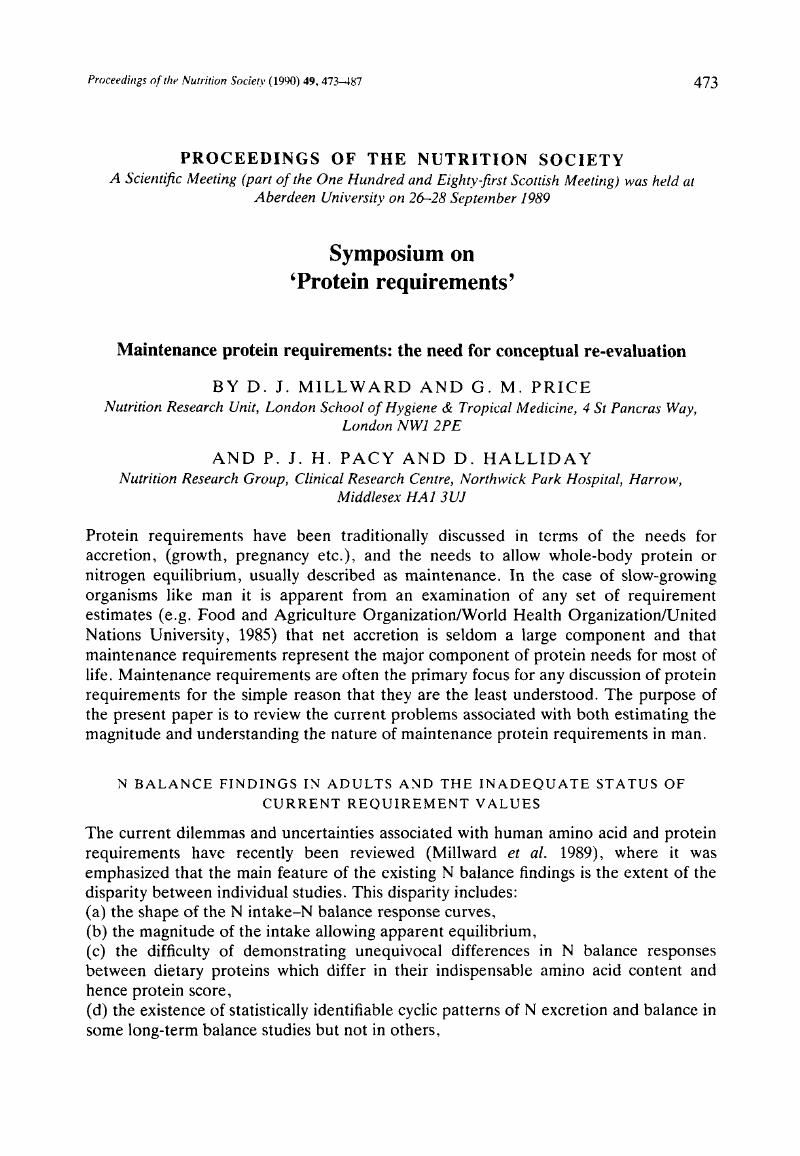Crossref Citations
This article has been cited by the following publications. This list is generated based on data provided by Crossref.
Reeds, Peter J.
1990.
Amino Acid Needs and Protein Scoring Patterns.
Proceedings of the Nutrition Society,
Vol. 49,
Issue. 3,
p.
489.
Young, V. R.
1991.
Nutrient interactions with reference to amino acid and protein metabolism in non-ruminants; particular emphasis on protein-energy relations in man.
Zeitschrift für Ernährungswissenschaft,
Vol. 30,
Issue. 4,
p.
239.
Weijs, P. J. M.
Schreurs, V. V. A. M.
Koopmanschap, R. E.
Grooten, H. N. A.
Schoonman, A. T.
and
Boekholt, H. A.
1993.
Effects of acute and chronic level of protein supply on metabolic leucine utilization in growing and mature rats.
British Journal of Nutrition,
Vol. 70,
Issue. 1,
p.
117.
Millward, J
1993.
Stable-isotope-tracer studies of amino acid balance and human indispensable amino acid requirements.
The American Journal of Clinical Nutrition,
Vol. 57,
Issue. 1,
p.
81.
Millward, Joe
1994.
Can We Define Indispensable Amino Acid Requirements and Assess Protein Quality in Adults?.
The Journal of Nutrition,
Vol. 124,
Issue. ,
p.
1509S.
Bergner, H.
1994.
Ermittlung der eiweissqualität von nahrungs‐ und futtermitteln*.
Archiv für Tierernaehrung,
Vol. 45,
Issue. 4,
p.
293.
Motil, Kathleen J
Opekun, Antone R
Montandon, Corinne M
Berthold, Heiner K
Davis, Teresa A
Klein, Peter D
and
Reeds, Peter J
1994.
Leucine Oxidation Changes Rapidly after Dietary Protein Intake is Altered in Adult Women but Lysine Flux Is Unchanged As Is Lysine Incorporation into VLDL-Apolipoprotein B-100.
The Journal of Nutrition,
Vol. 124,
Issue. 1,
p.
41.
Young, Vernon R
1994.
Adult Amino Acid Requirements: The Case for a Major Revision in Current Recommendations.
The Journal of Nutrition,
Vol. 124,
Issue. ,
p.
1517S.
Pannemans, DL
Halliday, D
and
Westerterp, KR
1995.
Whole-body protein turnover in elderly men and women: responses to two protein intakes.
The American Journal of Clinical Nutrition,
Vol. 61,
Issue. 1,
p.
33.
Young, Vernon R.
Yu, Yong-Ming
Fukagawa, Naomi K.
and
Raguso, Comasia A.
1997.
Homocysteine Metabolism: From Basic Science to Clinical Medicine.
Vol. 196,
Issue. ,
p.
11.
Gerrits, Walter J.J.
France, James
Dijkstra, Jan
Bosch, Marlou W.
Tolman, G. Henk
and
Tamminga, Seerp
1997.
Evaluation of a Model Integrating Protein and Energy Metabolism in Preruminant Calve ,.
The Journal of Nutrition,
Vol. 127,
Issue. 6,
p.
1243.
Millward, D.Joe
1997.
Human Amino Acid Requirements.
The Journal of Nutrition,
Vol. 127,
Issue. 9,
p.
1842.
Romon, M
Le Fur, C
Lebel, P
Edmé, JL
Fruchart, JC
and
Dallongeville, J
1997.
Circadian variation of postprandial lipemia.
The American Journal of Clinical Nutrition,
Vol. 65,
Issue. 4,
p.
934.
Millward, D. Joe
1998.
Metabolic Demands for Amino Acids and the Human Dietary Requirement: Revisited.
The Journal of Nutrition,
Vol. 128,
Issue. 12,
p.
S2563.
Gerrits, Walter J.J.
Schrama, Johan W.
and
Tamminga, Seerp
1998.
The Marginal Efficiency of Utilization of All Ileal Digestible Indispensable Amino Acids for Protein Gain Is Lower than 30% in Preruminant Calves between 80 and 240 kg Live Weight.
The Journal of Nutrition,
Vol. 128,
Issue. 10,
p.
1774.
Millward, D. J.
1998.
Plant Proteins from European Crops.
p.
169.
Fukagawa, Naomi K
Yu, Yong-Ming
and
Young, Vernon R
1998.
Methionine and cysteine kinetics at different intakes of methionine and cystine in elderly men and women.
The American Journal of Clinical Nutrition,
Vol. 68,
Issue. 2,
p.
380.
Raguso, Comasia A
Pereira, Paulo
and
Young, Vernon R
1999.
A tracer investigation of obligatory oxidative amino acid losses in healthy, young adults.
The American Journal of Clinical Nutrition,
Vol. 70,
Issue. 4,
p.
474.
Di Buono, Marco
Wykes, Linda J
Ball, Ronald O
and
Pencharz, Paul B
2001.
Total sulfur amino acid requirement in young men as determined by indicator amino acid oxidation with l-[1-13C]phenylalanine.
The American Journal of Clinical Nutrition,
Vol. 74,
Issue. 6,
p.
756.
SOETERS, P.B.
de JONG, C.H.
and
DEUTZ, N.E.P.
2001.
The protein sparing function of the gut and the quality of food protein.
Clinical Nutrition,
Vol. 20,
Issue. 2,
p.
97.



